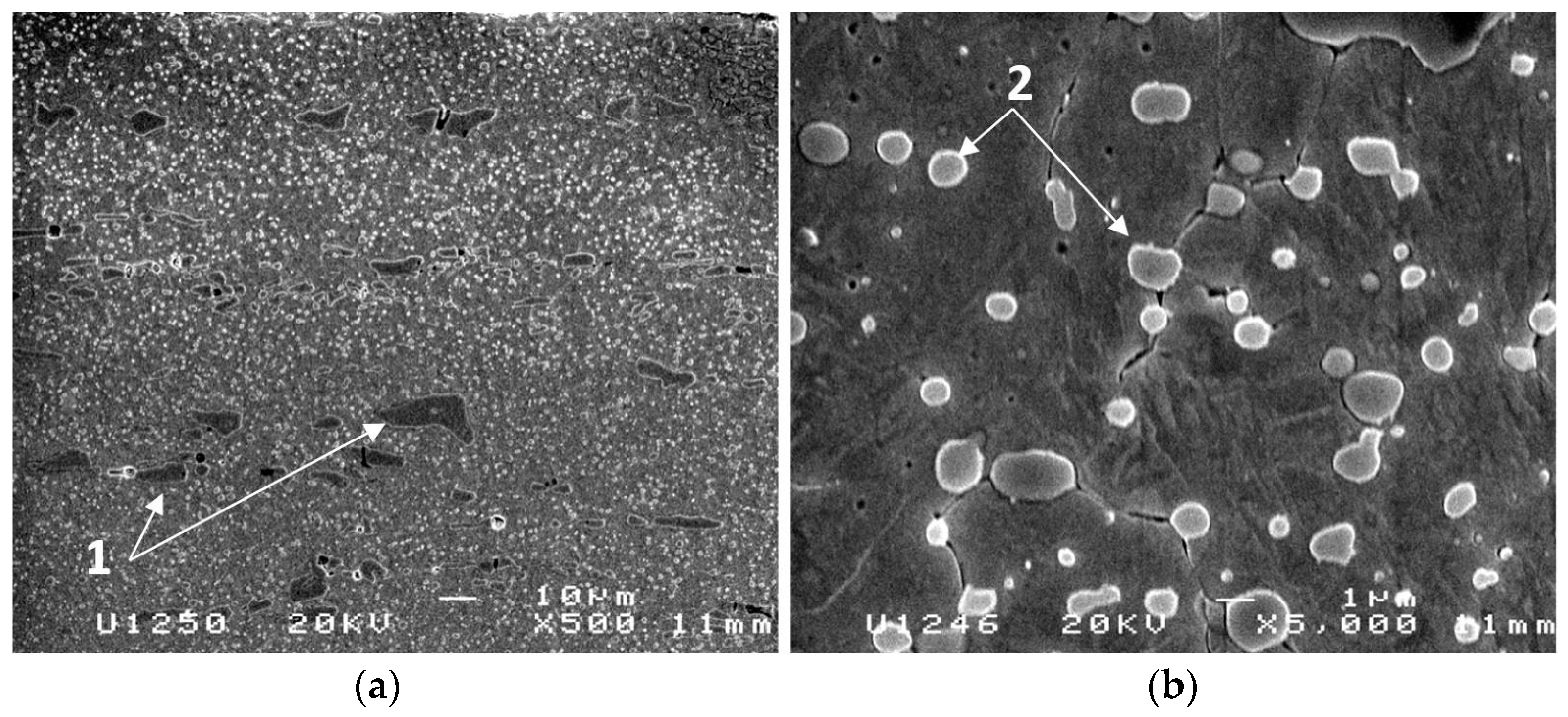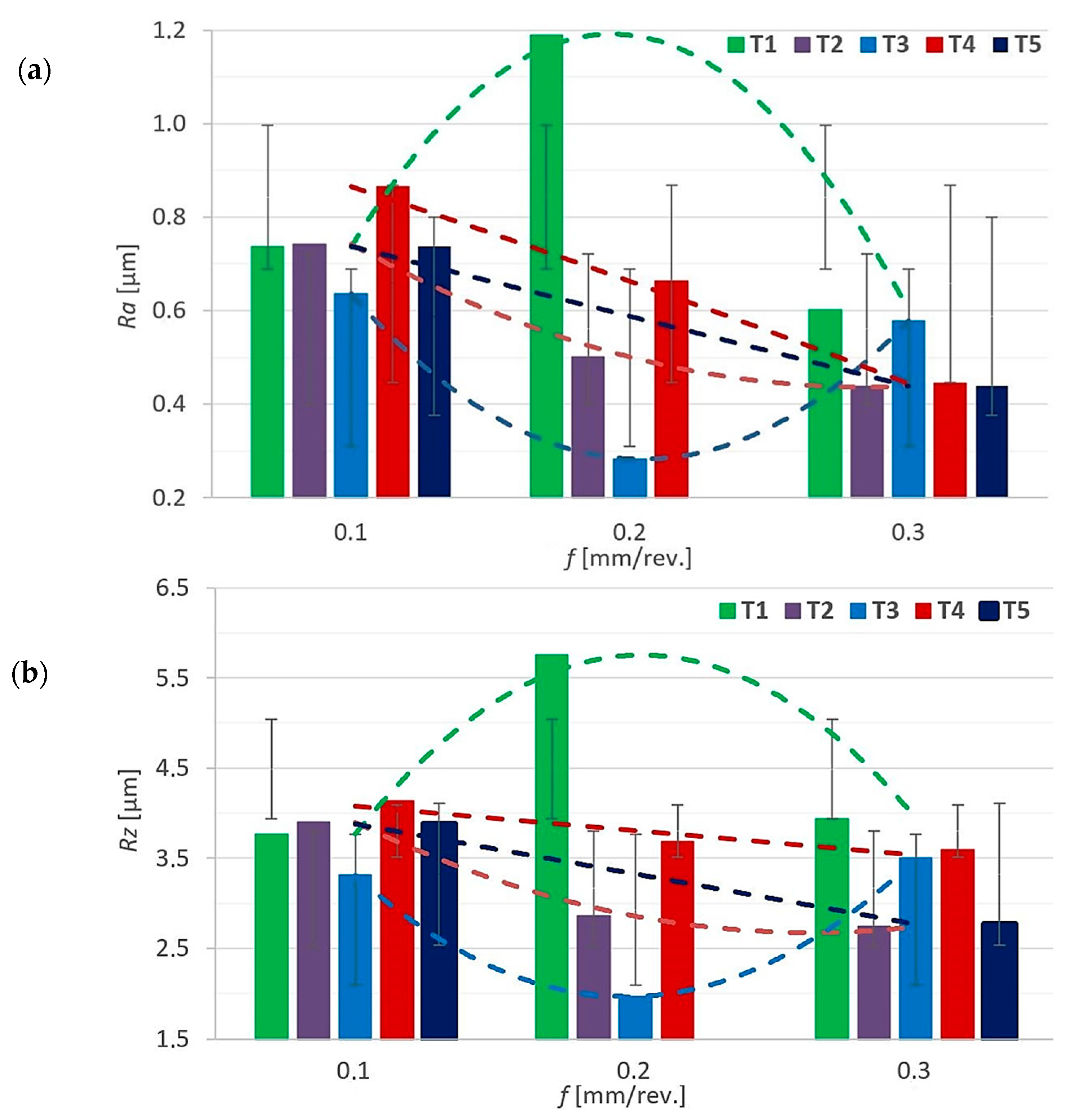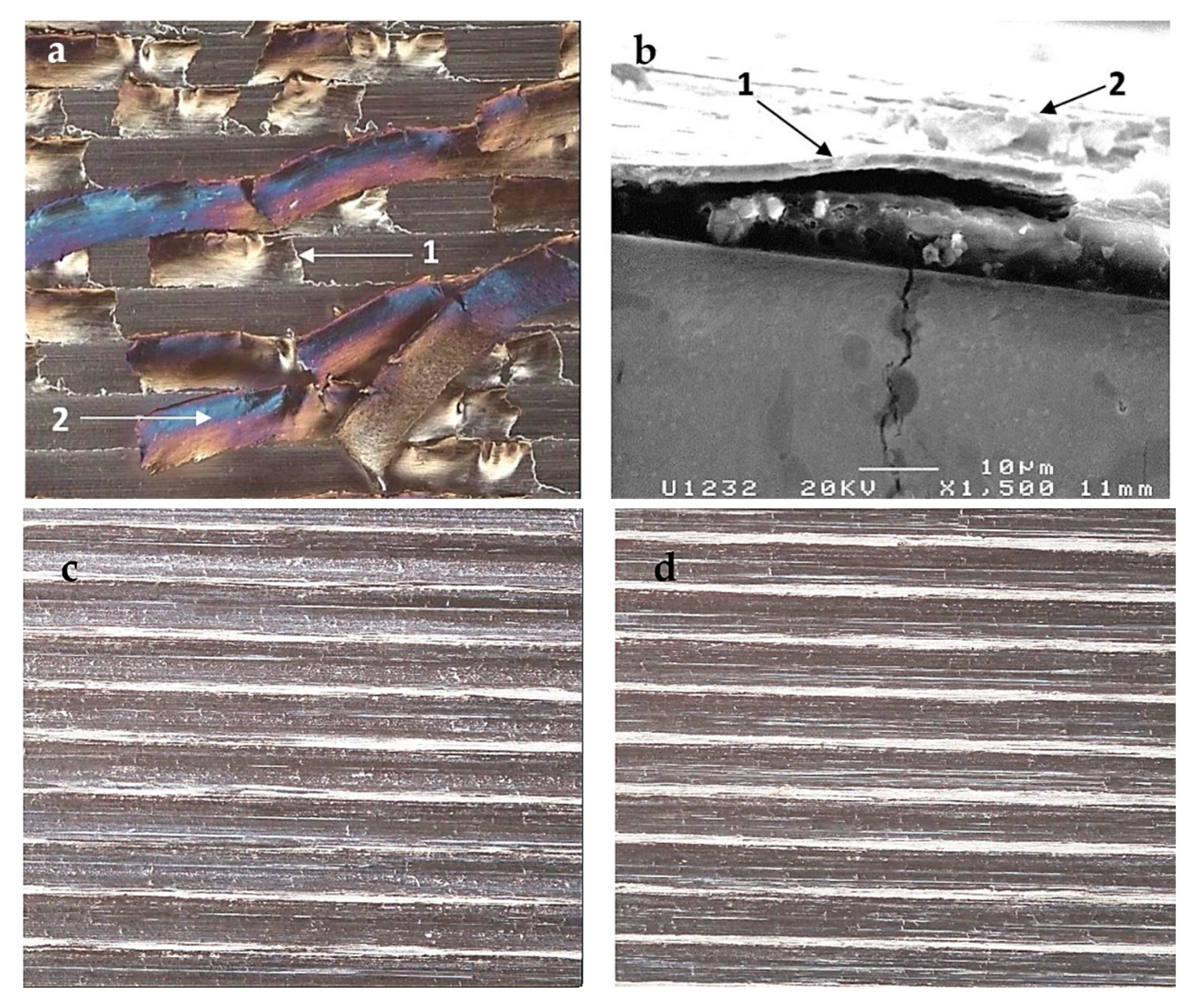The Geometric Surface Structure of EN X153CrMoV12 Tool Steel after Finish Turning Using PCBN Cutting Tools
Abstract
1. Introduction
- High-CBN (CBN-H), containing a large (70–95%) volume of CBN in the tool material, most often with a metallic binder;
- Low-CBN (CBN-L), containing a smaller (40–65%) volume of CBN in the tool material, most often with a ceramic binder (e.g., TiC, TiN).
2. Materials and Methods
3. Results and Discussion
4. Conclusions
- a positive effect of the use of anti-wear coatings on PBCN tools has been shown to reduce the values of the roughness parameters tested compared to uncoated tools,
- the lowest influence of the feed on the values of all tested roughness parameters was noted for surfaces treated with TiN-coated T2 tools (50 vol.% of CBN) and TiAlN-coated T3 (50 vol.% of CBN) tools,
- the lack of protective coating contributed to the occurrence of intense adhesive wear on the flank surface on the uncoated T1 tools, in the range of the feed values f = 0.2 and 0.3 [mm/rev.],
- the analysis of material surface after treatment with the uncoated T1 tool with the feed f = 0.2 [mm/rev.] showed the occurrence of the phenomenon of lateral material flow and numerous chip deflections,
- for all tested tools, the greatest changes in the microhardness of the structure after the turning process with a feed f = 0.3 [mm/rev.] were obtained for a depth of up to 100 µm, and the hardness of the material core for all tested tools was achieved at a depth of 400–500 µm from the outside material boundary,
- the most optimal parameters of the surface layer, equivalent to parameters after the grinding process, for all analyzed materials were obtained after processing with a feed value of f = 0.3 mm/rev.
Author Contributions
Funding
Institutional Review Board Statement
Informed Consent Statement
Data Availability Statement
Conflicts of Interest
References
- Rao, J.; Sharma, A.; Rose, T. Titanium aluminium nitride and titanium boride multilayer coatings designed to combat tool wear. Coatings 2017, 8, 12. [Google Scholar] [CrossRef]
- Boing, D.; Zilli, L.; Fries, C.E.; Schroeter, R.B. Tool wear rate of the PCBN, mixed ceramic, and coated cemented carbide in the hard turning of the AISI 52100 steel. Int. J. Adv. Manuf. Technol. 2019, 104, 4697–4704. [Google Scholar] [CrossRef]
- Radha Krishnan, B.; Aravindh, R.; Barathkumar, M.; Gowtham, K.; Hariharan, R. Prediction of surface roughness (AISI 4140 steel) in cylindrical grinding operation by RSM. Int. J. Res. Dev. Technol. 2018, 9, 702–704. [Google Scholar]
- Puerto, P.; Fernandez, R.; Madariaga, J.; Arana, J.; Gallego, I. Evolution of surface roughness in griding and its relationship with the dressing parameters and the radial wear. Procedia Eng. 2013, 63, 174–182. [Google Scholar] [CrossRef]
- Ociepa, M.; Jenek, M.; Feldshtein, E.; Leksycki, K. The phonomenon of material side flow during finish turning of EN X153CrMoV12 hardened steel with tools based on polycrystalline cubic boron nitride. J. Superhard Mater. 2019, 41, 265–271. [Google Scholar] [CrossRef]
- Tillmann, W.; Elrefaey, A.; Wojarski, L. Brazing of cutting tools. In Advances in Brazing—Science, Technology and Applications; Elsevier: Amsterdam, The Netherlands, 2013; pp. 423–471. [Google Scholar]
- Bushlya, V.M.; Gutnichenko, O.A.; Zhou, J.M.; Ståhl, J.-E.; Gunnarsson, S. Tool wear and tool life of PCBN, binderless cBN and wBN-cBN tools in continuous finish hard turning of cold work tool steel. J. Superhard Mater. 2014, 36, 49–60. [Google Scholar] [CrossRef]
- DIN ISO 513:2014–05. Classification and Application of Hard Cutting Materials for Metal Removal with Defined Cutting Edges—Designation of the Main Groups and Groups of Application (ISO 513:2012); Deutsches Institut für Normung: Berlin, Germany, 2014. [Google Scholar]
- Gsander, D. Chancen und Gränzen des high-performance cutting. Werkzeug Tech. 2002, 72, 35–37. [Google Scholar]
- Gordon, S.; Phelan, P.; Lahiff, C. The effect of high speed machining on the crater wear behaviour of PCBN tools in hard turning. Procedia Manuf. 2019, 38, 1833–1848. [Google Scholar] [CrossRef]
- Sveen, S.; Andersson, J.; M’Saoubi, R.; Olsson, M. Scratch adhesion characteristics of PVD TiAlN deposited on high speed steel, cemented carbide and PCBN substrates. Wear 2013, 308, 133–141. [Google Scholar] [CrossRef]
- Sousa, V.F.C.; Silva, F.J.G. Recent advances in turning processes using coated tools—A comprehensive review. Metals 2020, 10, 170. [Google Scholar] [CrossRef]
- Micallef, C.; Zhuk, Y.; Aria, A.I. Recent progress in precision machining and surface finishing of tungsten carbide hard composite coatings. Coatings 2020, 10, 731. [Google Scholar] [CrossRef]
- Caliskan, H.; Panjan, P.; Kurbanoglu, C. Hard Coatings on Cutting Tools and Surface Finish. In Comprehensive Materials Finishing; Elsevier: Amsterdam, The Netherlands, 2017; Chapter 3; pp. 230–242. [Google Scholar] [CrossRef]
- Taylan, F.; Colak, O.; Kayacan, M. Investigation of TiN coated CBN and CBN cutting tool performance in hard milling appli-cation, Strojniski vestnik. J. Mech. Eng. 2011, 57, 417–424. [Google Scholar]
- Galoppi, G.D.S.; Filho, M.S.; Batalha, G.F. Hard turning of tempered DIN 100Cr6 steel with coated and no coated CBN inserts. J. Mater. Process. Technol. 2006, 179, 146–153. [Google Scholar] [CrossRef]
- M’Saoubi, R.; Johansson, M.; Andersson, J. Wear mechanisms of PVD-coated PCBN cutting tools. Wear 2013, 302, 1219–1229. [Google Scholar] [CrossRef]
- Coelho, R.T.; Ng, E.-G.; Elbestawi, M. Tool wear when turning hardened AISI 4340 with coated PCBN tools using finishing cutting conditions. Int. J. Mach. Tools Manuf. 2007, 47, 263–272. [Google Scholar] [CrossRef]
- Sousa, V.; Da Silva, F.; Pinto, G.; Baptista, A.; Alexandre, R. Characteristics and wear mechanisms of TiAlN-based coatings for machining applications: A comprehensive review. Metals 2021, 11, 260. [Google Scholar] [CrossRef]
- Kuo, C.-C.; Lin, Y.-T.; Chan, A.; Chang, J.-T. High temperature wear behavior of titanium nitride coating deposited using high power impulse magnetron sputtering. Coatings 2019, 9, 555. [Google Scholar] [CrossRef]
- Badini, C.; Deambrosis, S.M.; Padovano, E.; Fabrizio, M.; Ostrovskaya, O.; Miorin, E.; D’Amico, G.C.; Montagner, F.; Biamino, S.; Zin, V. Thermal shock and oxidation behavior of HiPIMS TiAlN coatings grown on Ti–48Al–2Cr–2Nb intermetallic alloy. Materials 2016, 9, 961. [Google Scholar] [CrossRef] [PubMed]
- Manokhin, A.S.; Klimenko, S.A.; Klimenko, S.A.; Beresnev, V.M. Promising types of coatings for PCBN tools. J. Superhard Mater. 2018, 40, 424–431. [Google Scholar] [CrossRef]
- Poulachon, G.; Bandyopadhyay, B.; Jawahir, I.; Pheulpin, S.; Seguin, E. The influence of the microstructure of hardened tool steel workpiece on the wear of PCBN cutting tools. Int. J. Mach. Tools Manuf. 2003, 43, 139–144. [Google Scholar] [CrossRef]
- Yamamoto, K.; Inthidech, S.; Sasaguri, N.; Matsubara, Y. Influence of Mo and W on high temperature hardness of M7C3 carbide in high chromium white cast iron. Mater. Trans. 2014, 55, 684–689. [Google Scholar] [CrossRef]
- Dziedzic, K.; Józwik, J.; Barszcz, M.; Gauda, K. Wear characteristics of hard facing coatings obtained by tungsten inert gas method. Adv. Sci. Technol. Res. J. 2019, 13, 8–14. [Google Scholar] [CrossRef]
- Pytlak, B. Multicriteria optimization of hard turning operation of the hardened 18HGT steel. Int. J. Adv. Manuf. Technol. 2010, 49, 305–312. [Google Scholar] [CrossRef]
- Boing, D.; Schroeter, R.B.; De Oliveira, A.J. Three-dimensional wear parameters and wear mechanisms in turning hardened steels with PCBN tools. Wear 2018, 398–399, 69–78. [Google Scholar] [CrossRef]
- De Godoy, V.A.A.; Diniz, A.E. Turning of interrupted and continuous hardened steel surfaces using ceramic and CBN cutting tools. J. Mater. Process. Technol. 2011, 211, 1014–1025. [Google Scholar] [CrossRef][Green Version]
- Grzesik, W. Advanced Machining Processes of Metallic Materials—Theory, Modeling and Applications, 2nd ed.; Elsevier: Amsterdam, The Netherlands, 2017; p. 578. ISBN 978-0-444-63711-6. [Google Scholar]
- Wang, Y.; Cui, X.; Xu, H.; Jiang, K. Cutting force analysis in reaming of ZL102 aluminium cast alloys by PCD reamer. Int. J. Adv. Manuf. Technol. 2012, 67, 1509–1516. [Google Scholar] [CrossRef]
- Fuentes, J.A.O.; Keunecke, M. Analysis and application of CBN coated cutting tools. In Proceedings of the 7th International Conference “The Coatings in Manufacturing Engineering”, Chalkidiki, Greece, 1–3 October 1998. [Google Scholar]
- Uhlmann, E.; Braeuer, G.; Wiemann, E.; Keunecke, M. CBN coatings on cutting tools, production engineering. Res. Dev. Ger. Ann. Ger. Acad. Soc. Prod. Eng. 2004, 11, 45–48. [Google Scholar]
- Ociepa, M.; Jenek, M.; Feldshtein, E. On the wear comparative analysis of cutting tools made of composite materials based on polycrystalline cubic boron nitride when finish turning of AISI D2 (EN X153CrMoV12) steel. J. Superhard Mater. 2018, 40, 396–401. [Google Scholar] [CrossRef]
- Krbaťa, M.; Eckert, M.; Križan, D.; Barényi, I.; Mikušová, I. Hot deformation process analysis and modelling of X153CrMoV12 steel. Metals 2019, 9, 1125. [Google Scholar] [CrossRef]
- Panjan, P.; Drnovšek, A.; Gselman, P.; Čekada, M.; Bončina, T.; Merl, D.K. Influence of growth defects on the corrosion resistance of sputter-deposited TiAlN hard coatings. Coatings 2019, 9, 511. [Google Scholar] [CrossRef]
- EN ISO 4957:2018. Tool Steels; ISO: Geneva, Switzerland, 2018. [Google Scholar]
- EN ISO 4287:1997. Geometrical Product Specifications (GPS)—Surface Texture: Profile Method—Terms, Definitions and Surface Texture Parameters; ISO: Geneva, Switzerland, 1997. [Google Scholar]
- Kumar, C.; Patel, S.K.; Majumder, H.; Khan, A.; Naik, D.K. Numerical analysis of hard machining of AISI 52100 steel using uncoated and coated Al2O3-TiCN based mixed ceramic inserts. In Proceedings of the National Conference on Emerging Trends in Manufacturing & Automation Engineering, NCMAE, Gwalior, India, 6 October 2017. [Google Scholar]
- Urban, M.; Monkova, K. Research of tribological properties of 34CrNiMo6 steel in the production of a newly designed self-equalizing thrust bearing. Metals 2020, 10, 84. [Google Scholar] [CrossRef]
- Salcedo, M.C.; Coral, I.B.; Ochoa, G.V. Characterization of surface topography with Abbott Firestone curve. Contemp. Eng. Sci. 2018, 11, 3397–3407. [Google Scholar] [CrossRef]











| Chemical Composition (mas.%) | |||||
|---|---|---|---|---|---|
| C | Si | Mn | Cr | Mo | V |
| 1.5–1.7 | 0.15–0.4 | 0.15–0.45 | 11–13 | 0.7–1.0 | 0.6–0.8 |
| Material Type | T1 | T2 | T3 * | T4 * | T5 |
|---|---|---|---|---|---|
| Machining type | Continuous and slightly interrupted machining | Continuous machining | Continuous machining | Continuous machining | Continuous machining |
| PCBN structure | 60% CBN in a ceramic binder | 50% CBN in a ceramic binder | 50% CBN in a ceramic binder | 50% CBN in a ceramic binder | 65% CBN in a ceramic binder |
| Coating type | NONE | TiN (PVD) | TiAlN (PVD) | TiAlN (PVD) | TiAlN (PVD) |
| Coating thickness | – | 1–4 µm | 2–4 µm | 2–4 µm | 2–4 µm |
| Coating hardness | – | 2100–2600 HV | 2400–2800 HV | 2400–2800 HV | 2400–2800 HV |
| Chamfer | BN = 0.1 mm GB = 20° | BN = 0.1 mm GB = 30° | BN = 0.13 mm GB = 25° | BN = 0.13 mm GB = 25° | BN = 0.12 mm GB = 25° |
| Cutting edge radius ** | 21.7 µm | 17.17 µm | 25.26 µm | 24.12 µm | 22.02 µm |
Publisher’s Note: MDPI stays neutral with regard to jurisdictional claims in published maps and institutional affiliations. |
© 2021 by the authors. Licensee MDPI, Basel, Switzerland. This article is an open access article distributed under the terms and conditions of the Creative Commons Attribution (CC BY) license (https://creativecommons.org/licenses/by/4.0/).
Share and Cite
Ociepa, M.; Jenek, M.; Kuryło, P. The Geometric Surface Structure of EN X153CrMoV12 Tool Steel after Finish Turning Using PCBN Cutting Tools. Coatings 2021, 11, 428. https://doi.org/10.3390/coatings11040428
Ociepa M, Jenek M, Kuryło P. The Geometric Surface Structure of EN X153CrMoV12 Tool Steel after Finish Turning Using PCBN Cutting Tools. Coatings. 2021; 11(4):428. https://doi.org/10.3390/coatings11040428
Chicago/Turabian StyleOciepa, Michał, Mariusz Jenek, and Piotr Kuryło. 2021. "The Geometric Surface Structure of EN X153CrMoV12 Tool Steel after Finish Turning Using PCBN Cutting Tools" Coatings 11, no. 4: 428. https://doi.org/10.3390/coatings11040428
APA StyleOciepa, M., Jenek, M., & Kuryło, P. (2021). The Geometric Surface Structure of EN X153CrMoV12 Tool Steel after Finish Turning Using PCBN Cutting Tools. Coatings, 11(4), 428. https://doi.org/10.3390/coatings11040428






